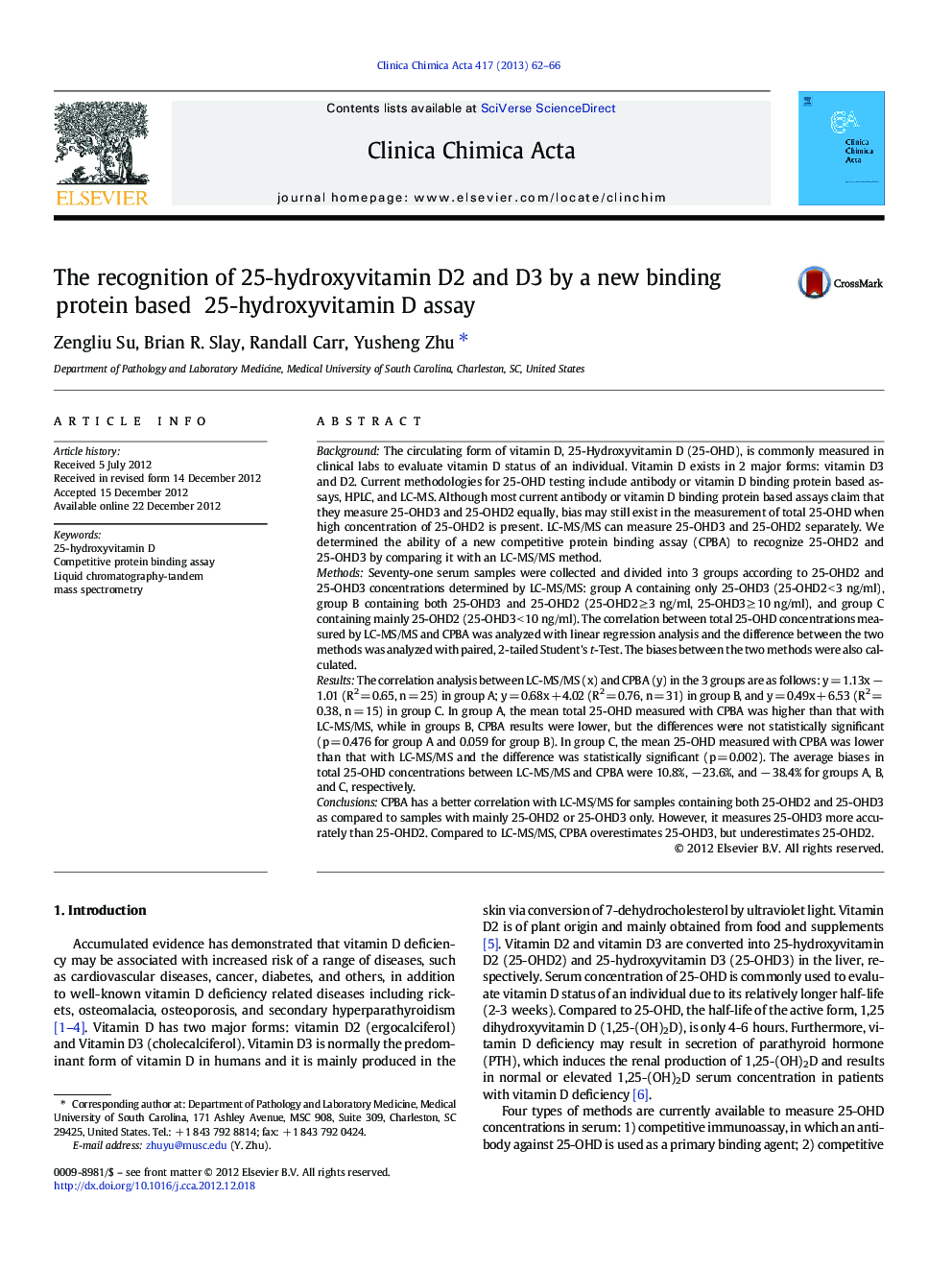| کد مقاله | کد نشریه | سال انتشار | مقاله انگلیسی | نسخه تمام متن |
|---|---|---|---|---|
| 1965805 | 1538681 | 2013 | 5 صفحه PDF | دانلود رایگان |

BackgroundThe circulating form of vitamin D, 25-Hydroxyvitamin D (25-OHD), is commonly measured in clinical labs to evaluate vitamin D status of an individual. Vitamin D exists in 2 major forms: vitamin D3 and D2. Current methodologies for 25-OHD testing include antibody or vitamin D binding protein based assays, HPLC, and LC-MS. Although most current antibody or vitamin D binding protein based assays claim that they measure 25-OHD3 and 25-OHD2 equally, bias may still exist in the measurement of total 25-OHD when high concentration of 25-OHD2 is present. LC-MS/MS can measure 25-OHD3 and 25-OHD2 separately. We determined the ability of a new competitive protein binding assay (CPBA) to recognize 25-OHD2 and 25-OHD3 by comparing it with an LC-MS/MS method.MethodsSeventy-one serum samples were collected and divided into 3 groups according to 25-OHD2 and 25-OHD3 concentrations determined by LC-MS/MS: group A containing only 25-OHD3 (25-OHD2 < 3 ng/ml), group B containing both 25-OHD3 and 25-OHD2 (25-OHD2 ≥ 3 ng/ml, 25-OHD3 ≥ 10 ng/ml), and group C containing mainly 25-OHD2 (25-OHD3 < 10 ng/ml). The correlation between total 25-OHD concentrations measured by LC-MS/MS and CPBA was analyzed with linear regression analysis and the difference between the two methods was analyzed with paired, 2-tailed Student's t-Test. The biases between the two methods were also calculated.ResultsThe correlation analysis between LC-MS/MS (x) and CPBA (y) in the 3 groups are as follows: y = 1.13x − 1.01 (R2 = 0.65, n = 25) in group A; y = 0.68x + 4.02 (R2 = 0.76, n = 31) in group B, and y = 0.49x + 6.53 (R2 = 0.38, n = 15) in group C. In group A, the mean total 25-OHD measured with CPBA was higher than that with LC-MS/MS, while in groups B, CPBA results were lower, but the differences were not statistically significant (p = 0.476 for group A and 0.059 for group B). In group C, the mean 25-OHD measured with CPBA was lower than that with LC-MS/MS and the difference was statistically significant (p = 0.002). The average biases in total 25-OHD concentrations between LC-MS/MS and CPBA were 10.8%, − 23.6%, and − 38.4% for groups A, B, and C, respectively.ConclusionsCPBA has a better correlation with LC-MS/MS for samples containing both 25-OHD2 and 25-OHD3 as compared to samples with mainly 25-OHD2 or 25-OHD3 only. However, it measures 25-OHD3 more accurately than 25-OHD2. Compared to LC-MS/MS, CPBA overestimates 25-OHD3, but underestimates 25-OHD2.
► Vitamin D2 is the only prescription supplement of vitamin D in the US.
► Method used in clinical laboratories should recognize 25-OHD2 and 25-OHD3 equally.
► A new competitive protein binding assay (CPBA) was compared with LC-MS/MS method.
► The new CPBA overestimates 25-OHD3 but underestimates 25-OHD2.
Journal: Clinica Chimica Acta - Volume 417, 18 February 2013, Pages 62–66